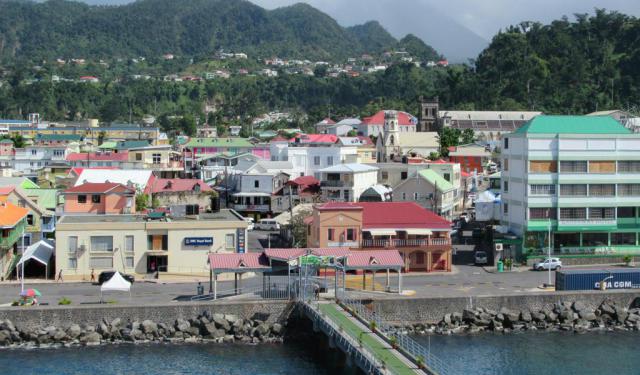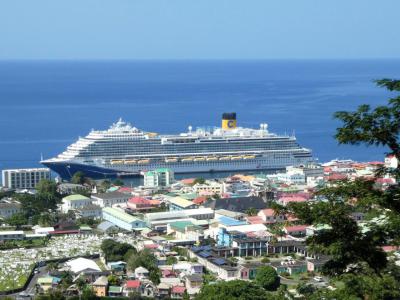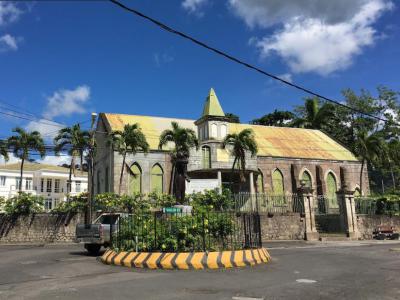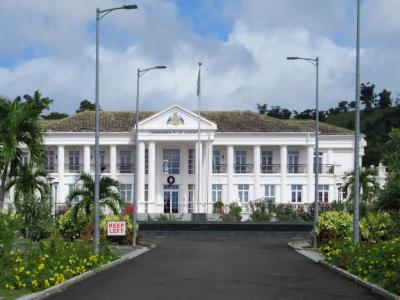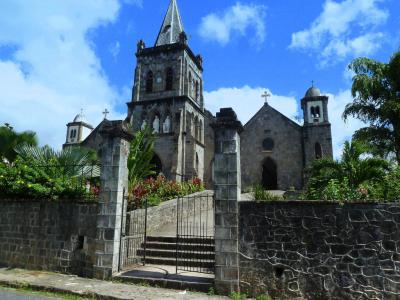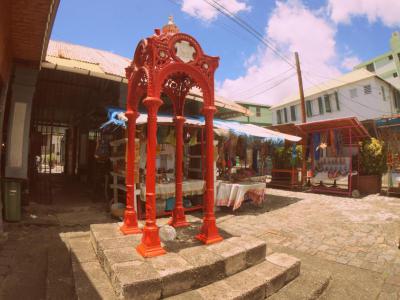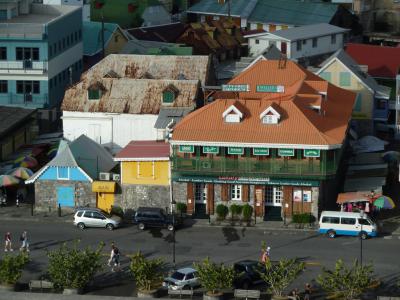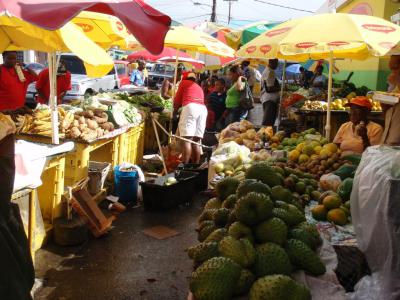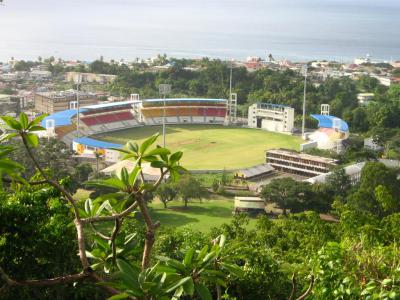Audio Guide: Roseau Introduction Walking Tour (Self Guided), Roseau
Roseau, the capital of the Caribbean nation of Dominica, marks the site of the oldest and most important urban settlement on the island.
Although European ships first appeared off the coast of Dominica in the 15th century, over the next hundred years it was inhabited only by Carib Indians, who settled the area of today's Roseau attracted by the nearby river. The French founded the town on the site of an Indian settlement in the 17th century. Following their tradition of naming places after what they found locally, the French used their word for the reed that grew in abundance along the river banks.
By the early 18th century, French settlers, primarily engaged in forestry and agriculture, populated the island's southwest coast, importing slaves from West Africa to work on coffee plantations.
Historically, Dominica, in general, and Roseau, in particular, were the subject of a struggle between France and another colonial power, Great Britain. The 1761 capture of Roseau by the British marked the beginning of their rule, ultimately confirmed by the Treaty of Versailles in 1783. Renamed Charlotte Town, the town became the island's capital in 1768.
In 1805, during military operations, the French completely burned the city, practically stopping its development for another several decades. The abolition of slavery in 1833 saw Roseau emerge as a center of governance. After Dominica's independence in 1978, it became the nation's capital but faced challenges such as the devastation caused by Hurricane David in 1979 and subsequent hurricanes in 1995. Despite adversities, though, Roseau persisted, with tourism emerging as a key economic driver.
While the English influence is seen in the architecture and street names, the French influence is obvious in the grid plan, with crooked streets extending from the city center to the limits. In the center lies the bustling Old Market Plaza, formerly a slave auction site, where the heartbeat of Roseau is best felt.
The nearby Dominica Museum showcases artifacts and exhibits detailing the island's natural and cultural history. Meanwhile, nature lovers can wander through the lush Dominica Botanic Gardens or hike up Morne Bruce for panoramic views of the city and surrounding landscape.
So, whatever your interest, welcome to Roseau! Come and discover the warmth and charm of this Eastern Caribbean gem with this self-guided walking tour.
Although European ships first appeared off the coast of Dominica in the 15th century, over the next hundred years it was inhabited only by Carib Indians, who settled the area of today's Roseau attracted by the nearby river. The French founded the town on the site of an Indian settlement in the 17th century. Following their tradition of naming places after what they found locally, the French used their word for the reed that grew in abundance along the river banks.
By the early 18th century, French settlers, primarily engaged in forestry and agriculture, populated the island's southwest coast, importing slaves from West Africa to work on coffee plantations.
Historically, Dominica, in general, and Roseau, in particular, were the subject of a struggle between France and another colonial power, Great Britain. The 1761 capture of Roseau by the British marked the beginning of their rule, ultimately confirmed by the Treaty of Versailles in 1783. Renamed Charlotte Town, the town became the island's capital in 1768.
In 1805, during military operations, the French completely burned the city, practically stopping its development for another several decades. The abolition of slavery in 1833 saw Roseau emerge as a center of governance. After Dominica's independence in 1978, it became the nation's capital but faced challenges such as the devastation caused by Hurricane David in 1979 and subsequent hurricanes in 1995. Despite adversities, though, Roseau persisted, with tourism emerging as a key economic driver.
While the English influence is seen in the architecture and street names, the French influence is obvious in the grid plan, with crooked streets extending from the city center to the limits. In the center lies the bustling Old Market Plaza, formerly a slave auction site, where the heartbeat of Roseau is best felt.
The nearby Dominica Museum showcases artifacts and exhibits detailing the island's natural and cultural history. Meanwhile, nature lovers can wander through the lush Dominica Botanic Gardens or hike up Morne Bruce for panoramic views of the city and surrounding landscape.
So, whatever your interest, welcome to Roseau! Come and discover the warmth and charm of this Eastern Caribbean gem with this self-guided walking tour.
How it works: Download the app "GPSmyCity: Walks in 1K+ Cities" from Apple App Store or Google Play Store to your mobile phone or tablet. The app turns your mobile device into a personal tour guide and its built-in GPS navigation functions guide you from one tour stop to next. The app works offline, so no data plan is needed when traveling abroad.
Roseau Introduction Walking Tour Map
Guide Name: Roseau Introduction Walking Tour
Guide Location: Dominica » Roseau (See other walking tours in Roseau)
Guide Type: Self-guided Walking Tour (Sightseeing)
# of Attractions: 11
Tour Duration: 2 Hour(s)
Travel Distance: 2.9 Km or 1.8 Miles
Author: DanaOffice
Sight(s) Featured in This Guide:
Guide Location: Dominica » Roseau (See other walking tours in Roseau)
Guide Type: Self-guided Walking Tour (Sightseeing)
# of Attractions: 11
Tour Duration: 2 Hour(s)
Travel Distance: 2.9 Km or 1.8 Miles
Author: DanaOffice
Sight(s) Featured in This Guide:
- Dominica Cruise Terminal
- The Dominica Museum
- St. George's Anglican Church
- Government House
- Cathedral of Our Lady of Fair Haven of Roseau
- Old Market Square
- Dame Mary Eugenia Charles Blvd
- Farmers Market
- Windsor Park
- Dominica Botanic Gardens
- Morne Bruce
1) Dominica Cruise Terminal
The Dominica Cruise Terminal, located in Roseau, sits conveniently on the outskirts of downtown, directly opposite the Dominica Museum. From this central location, visitors can easily explore the city’s attractions on foot, while reaching other parts of the island typically requires a taxi or pre-arranged shore excursion.
The cruise port offers a range of facilities to meet travelers’ needs, including shops and cafés for browsing and refreshments. Taxis are readily available, providing convenient transportation for those wishing to venture beyond downtown.
Many of Dominica’s main attractions focus on the island’s dramatic natural landscapes, which can present challenges for individuals with limited mobility. Visitors are encouraged to come prepared for outdoor excursions, bringing sun protection and wearing comfortable footwear suitable for navigating uneven or rugged terrain.
Overall, the Dominica Cruise Terminal serves as an accessible gateway to Roseau and the wider island, offering convenience, amenities, and the starting point for exploring Dominica’s rich cultural and natural offerings.
The cruise port offers a range of facilities to meet travelers’ needs, including shops and cafés for browsing and refreshments. Taxis are readily available, providing convenient transportation for those wishing to venture beyond downtown.
Many of Dominica’s main attractions focus on the island’s dramatic natural landscapes, which can present challenges for individuals with limited mobility. Visitors are encouraged to come prepared for outdoor excursions, bringing sun protection and wearing comfortable footwear suitable for navigating uneven or rugged terrain.
Overall, the Dominica Cruise Terminal serves as an accessible gateway to Roseau and the wider island, offering convenience, amenities, and the starting point for exploring Dominica’s rich cultural and natural offerings.
2) The Dominica Museum (must see)
The Dominica Museum serves as the national repository of the island nation’s cultural heritage, located in the heart of Roseau, on a quay beside the historic Old Market. This area has long been a center of commerce and historical significance, including its role in the transatlantic slave trade during the colonial era. The museum occupies a building dating back to 1810, which originally functioned as a market and post office. Today, it preserves and presents the rich cultural, social, geological, and archaeological history of Dominica, offering visitors a comprehensive overview of the island’s past and present.
Inside, the museum’s collection includes old photographs, portraits of past rulers, and colonial-era furniture such as chairs, cabinets, and barometers. These artifacts provide insight into the island’s colonial administration, social life, and the evolution of local customs. Agricultural tools and preserved specimens of birds and fish highlight Dominica’s biodiversity and the important role of farming and fishing in the island’s economy over the centuries.
The museum also showcases artifacts of the island’s indigenous peoples, including Arawak pottery and tools, Pwi pwi miniature rafts, and replicas of Carib huts. These exhibits illustrate the daily lives, craftsmanship, and maritime practices of Dominica’s earliest inhabitants. Geological exhibits explore the island’s volcanic activity, including displays of rocks and soil samples, helping visitors understand the natural forces that shaped the island.
Additional artifacts include items from early settlers, such as wooden figurines, domestic implements, and traditional musical instruments. Collectively, these exhibits provide a vivid picture of Dominica’s cultural and historical development, from its indigenous roots and colonial encounters to its modern-day identity.
Inside, the museum’s collection includes old photographs, portraits of past rulers, and colonial-era furniture such as chairs, cabinets, and barometers. These artifacts provide insight into the island’s colonial administration, social life, and the evolution of local customs. Agricultural tools and preserved specimens of birds and fish highlight Dominica’s biodiversity and the important role of farming and fishing in the island’s economy over the centuries.
The museum also showcases artifacts of the island’s indigenous peoples, including Arawak pottery and tools, Pwi pwi miniature rafts, and replicas of Carib huts. These exhibits illustrate the daily lives, craftsmanship, and maritime practices of Dominica’s earliest inhabitants. Geological exhibits explore the island’s volcanic activity, including displays of rocks and soil samples, helping visitors understand the natural forces that shaped the island.
Additional artifacts include items from early settlers, such as wooden figurines, domestic implements, and traditional musical instruments. Collectively, these exhibits provide a vivid picture of Dominica’s cultural and historical development, from its indigenous roots and colonial encounters to its modern-day identity.
3) St. George's Anglican Church
Saint George’s Anglican Church, originally constructed in the Regency architectural style, has long served as a place of worship and a focal point for the Roseau community. The church is a square, solid stone structure featuring long, slender windows and three hip roofs that extend from east to west, reflecting the simplicity and elegance typical of Regency-era design. For decades, it stood as both a spiritual center and a landmark of historical and architectural significance on the island of Dominica.
On September 18th, 2017, Hurricane Maria struck Dominica with devastating force, causing extensive damage across the island. Saint George’s Anglican Church was not spared, as the hurricane destroyed much of its roof and inflicted structural damage on the building. Despite this, the church remains a resilient symbol of faith, continuing to hold significance for locals and visitors alike. Reconstruction and restoration efforts aim to preserve the church’s historical character while ensuring its structural stability for future generations.
Adjacent to the church lies the Anglican cemetery, one of Dominica’s most historically important burial grounds. It contains the island’s oldest tombstones and inscriptions, providing invaluable insight into the early settlers, clergy, and prominent families of Roseau. Visitors can explore the cemetery to learn about the island’s colonial history and the individuals who shaped its cultural and social development.
On September 18th, 2017, Hurricane Maria struck Dominica with devastating force, causing extensive damage across the island. Saint George’s Anglican Church was not spared, as the hurricane destroyed much of its roof and inflicted structural damage on the building. Despite this, the church remains a resilient symbol of faith, continuing to hold significance for locals and visitors alike. Reconstruction and restoration efforts aim to preserve the church’s historical character while ensuring its structural stability for future generations.
Adjacent to the church lies the Anglican cemetery, one of Dominica’s most historically important burial grounds. It contains the island’s oldest tombstones and inscriptions, providing invaluable insight into the early settlers, clergy, and prominent families of Roseau. Visitors can explore the cemetery to learn about the island’s colonial history and the individuals who shaped its cultural and social development.
4) Government House
Government House serves as the official residence of the President of Dominica, though its origins date back to the colonial era, when it was the residence of the island’s colonial governors.
Perched atop a low hill south of Roseau’s bustling commercial center, Government House commands a stately presence within the city. Its strategic location provides commanding views of the surrounding area, reflecting its historical importance as a seat of authority.
Accounts from the 1790s describe the grounds as being lushly landscaped, with an avenue of trees and a variety of ornamental plants. Over the years, the gardens have occasionally suffered damage from hurricanes, yet they have been restored,.
Originally built for the British governors, and later briefly used by French authorities, Government House assumed its current role following Dominica’s independence in 1978. Since that time, it has housed the President of Dominica, symbolizing the nation’s sovereignty.
Perched atop a low hill south of Roseau’s bustling commercial center, Government House commands a stately presence within the city. Its strategic location provides commanding views of the surrounding area, reflecting its historical importance as a seat of authority.
Accounts from the 1790s describe the grounds as being lushly landscaped, with an avenue of trees and a variety of ornamental plants. Over the years, the gardens have occasionally suffered damage from hurricanes, yet they have been restored,.
Originally built for the British governors, and later briefly used by French authorities, Government House assumed its current role following Dominica’s independence in 1978. Since that time, it has housed the President of Dominica, symbolizing the nation’s sovereignty.
5) Cathedral of Our Lady of Fair Haven of Roseau
The Cathedral of Our Lady of Fair Haven of Roseau stands as a prominent symbol of the Roman Catholic faith in the Caribbean. Constructed in the Gothic Romanesque Revival style, the cathedral’s current form dates back to its consecration in 1916. Despite its modest exterior, the interior is remarkably spacious and well-lit, offering a serene sanctuary for worshippers.
Built from volcanic rock both inside and out, the cathedral is designed to withstand seismic activity, reflecting the fusion of European and local influences in Dominica’s architectural landscape. Its bell tower, with a stout structure and prominent clock, contributes to the cathedral’s distinctive presence.
The cathedral’s Gothic-style stained-glass windows feature intricate designs that allow natural light to fill the interior. Wooden shutters along the lower sections of the windows provide ventilation while enhancing the architectural character. Among the notable features is a stained-glass window dedicated to Christopher Columbus, commemorating the region’s historical heritage.
Inside, Victorian-style pews and ornate murals adorn the walls. The cathedral’s organ, installed in January 1883, adds a harmonious element to the worship experience, complementing the space with its melodic tones.
Built from volcanic rock both inside and out, the cathedral is designed to withstand seismic activity, reflecting the fusion of European and local influences in Dominica’s architectural landscape. Its bell tower, with a stout structure and prominent clock, contributes to the cathedral’s distinctive presence.
The cathedral’s Gothic-style stained-glass windows feature intricate designs that allow natural light to fill the interior. Wooden shutters along the lower sections of the windows provide ventilation while enhancing the architectural character. Among the notable features is a stained-glass window dedicated to Christopher Columbus, commemorating the region’s historical heritage.
Inside, Victorian-style pews and ornate murals adorn the walls. The cathedral’s organ, installed in January 1883, adds a harmonious element to the worship experience, complementing the space with its melodic tones.
6) Old Market Square (must see)
The Old Market Square, also known as Old Market Plaza or Dawbiney Market Square, is a historic landmark located in the heart of Roseau. Positioned behind the Dominica Museum along the scenic seafront, the square has long been central to the city’s social, economic, and cultural life. Its history stretches back to colonial times.
In its early days, Old Market Square functioned as a bustling center of commerce, where traders and locals exchanged a wide variety of goods, including provisions, textiles, and agricultural products. The square also played a darker role in history, as it was a site associated with the transatlantic slave trade and public executions, bearing witness to the hardships and injustices of the colonial era. Despite this grim past, the square remained a focal point for civic life, hosting gatherings and serving as a meeting place for the community.
By the late 20th century, efforts were made to preserve the square’s historical significance while adapting it to contemporary cultural and commercial use. In 1988, Old Market Square underwent a major renovation, transforming it into a vibrant craft center. Today, the plaza features a variety of small shops and stalls where visitors can purchase locally made crafts, from handcrafted jewelry and woven baskets to traditional T-shirts, spices, and culinary specialties.
The square continues to host cultural events, including festivals, performances, and art exhibitions, celebrating the island’s heritage and creative spirit.
In its early days, Old Market Square functioned as a bustling center of commerce, where traders and locals exchanged a wide variety of goods, including provisions, textiles, and agricultural products. The square also played a darker role in history, as it was a site associated with the transatlantic slave trade and public executions, bearing witness to the hardships and injustices of the colonial era. Despite this grim past, the square remained a focal point for civic life, hosting gatherings and serving as a meeting place for the community.
By the late 20th century, efforts were made to preserve the square’s historical significance while adapting it to contemporary cultural and commercial use. In 1988, Old Market Square underwent a major renovation, transforming it into a vibrant craft center. Today, the plaza features a variety of small shops and stalls where visitors can purchase locally made crafts, from handcrafted jewelry and woven baskets to traditional T-shirts, spices, and culinary specialties.
The square continues to host cultural events, including festivals, performances, and art exhibitions, celebrating the island’s heritage and creative spirit.
7) Dame Mary Eugenia Charles Blvd
Dame Mary Eugenia Charles Boulevard, also known as Roseau Bayfront, is a cherished waterfront promenade in the heart of Roseau. Its history dates back to the 18th century, when Dominica was a French colony and the area served as a bustling port for trade between Europe, Africa, and the Americas.
Following British colonization in the late 1700s, the Bayfront continued to thrive as a vital commercial center. Over the 19th and early 20th centuries, the area underwent significant transformations, including the construction of a seawall in the late 1800s. This development facilitated the creation of a scenic promenade along the waterfront, originally named after Queen Victoria, reflecting the enduring ties to the British monarchy.
In 1974, the boulevard was renamed Dame Mary Eugenia Charles Boulevard in honor of Dame Mary Eugenia Charles, Dominica’s first female Prime Minister. Her leadership was instrumental in guiding the country to independence from Britain in 1978, and she is celebrated as a national hero.
Today, the boulevard remains a vibrant destination for both locals and visitors. Its picturesque setting along the Caribbean Sea attracts people for leisurely walks, while a variety of restaurants, bars, and shops line the promenade, offering dining, socializing, and shopping opportunities. Despite sustaining damage during Hurricane Maria in 2017, ongoing restoration efforts have preserved its appeal, maintaining Roseau Bayfront as a central and lively part of the city.
Following British colonization in the late 1700s, the Bayfront continued to thrive as a vital commercial center. Over the 19th and early 20th centuries, the area underwent significant transformations, including the construction of a seawall in the late 1800s. This development facilitated the creation of a scenic promenade along the waterfront, originally named after Queen Victoria, reflecting the enduring ties to the British monarchy.
In 1974, the boulevard was renamed Dame Mary Eugenia Charles Boulevard in honor of Dame Mary Eugenia Charles, Dominica’s first female Prime Minister. Her leadership was instrumental in guiding the country to independence from Britain in 1978, and she is celebrated as a national hero.
Today, the boulevard remains a vibrant destination for both locals and visitors. Its picturesque setting along the Caribbean Sea attracts people for leisurely walks, while a variety of restaurants, bars, and shops line the promenade, offering dining, socializing, and shopping opportunities. Despite sustaining damage during Hurricane Maria in 2017, ongoing restoration efforts have preserved its appeal, maintaining Roseau Bayfront as a central and lively part of the city.
8) Farmers Market
The Roseau Farmers Market is one of the top attractions in Roseau, offering visitors a vibrant mix of local flavors, products, and traditions.
Centrally located in the capital, the market draws visitors with its colorful stalls and lively atmosphere. Local farmers and vendors proudly display a wide range of fresh tropical fruits, vegetables, herbs, and spices, providing a glimpse into Dominica's rich agricultural heritage. From succulent mangoes and ripe bananas to fragrant herbs and exotic spices, the market showcases the diverse bounty of the island’s fertile land.
In addition to fresh produce, the market features an extensive selection of local crafts and souvenirs, highlighting the talents of Dominican artisans. Visitors can browse handmade jewelry, intricately woven baskets, wood carvings, and other unique items, each reflecting the island’s culture and traditions.
For those eager to sample local cuisine, the Roseau Farmers Market includes a food court serving traditional Dominican dishes. From hearty callaloo soup to flavorful pelau and the famed “Mountain Chicken” (a local delicacy), visitors can enjoy an authentic taste of the island amidst the lively market atmosphere.
Open Monday through Saturday, with Saturdays being the busiest, the market offers an immersive experience for visitors eager to explore Dominica’s sights, sounds, and flavors. Mornings provide the freshest produce and most energetic ambiance, while the market remains lively throughout the day, often accompanied by live music and cultural performances.
Centrally located in the capital, the market draws visitors with its colorful stalls and lively atmosphere. Local farmers and vendors proudly display a wide range of fresh tropical fruits, vegetables, herbs, and spices, providing a glimpse into Dominica's rich agricultural heritage. From succulent mangoes and ripe bananas to fragrant herbs and exotic spices, the market showcases the diverse bounty of the island’s fertile land.
In addition to fresh produce, the market features an extensive selection of local crafts and souvenirs, highlighting the talents of Dominican artisans. Visitors can browse handmade jewelry, intricately woven baskets, wood carvings, and other unique items, each reflecting the island’s culture and traditions.
For those eager to sample local cuisine, the Roseau Farmers Market includes a food court serving traditional Dominican dishes. From hearty callaloo soup to flavorful pelau and the famed “Mountain Chicken” (a local delicacy), visitors can enjoy an authentic taste of the island amidst the lively market atmosphere.
Open Monday through Saturday, with Saturdays being the busiest, the market offers an immersive experience for visitors eager to explore Dominica’s sights, sounds, and flavors. Mornings provide the freshest produce and most energetic ambiance, while the market remains lively throughout the day, often accompanied by live music and cultural performances.
9) Windsor Park
Windsor Park is Dominica’s premier multi-purpose stadium, located in the heart of Roseau. The venue plays a central role in the island's sporting and cultural life, hosting a wide range of events that unite communities and celebrate Dominican heritage. Beyond sports, Windsor Park serves as a key location for carnival activities, state parades, and cultural celebrations.
Originally built on the site of a former rubbish dump known as Cow Town, Windsor Park has undergone a remarkable transformation to become a world-class sporting facility. It serves as Dominica’s national stadium, primarily used for cricket and association football matches, but its versatility allows it to host concerts, festivals, and major cultural events such as the World Creole Music Festival, the finals of the Calypso Competition, and the Miss Dominica pageant.
The stadium is equipped with modern facilities that meet International Cricket Council standards, including digital scoreboards and five cricket pitches, providing an excellent experience for both players and spectators.
Over the years, Windsor Park has witnessed many historic moments. Notably, it hosted the Dominica national football team’s first 2010 World Cup qualifying match against Barbados, attracting 4,200 spectators. In 2009, the stadium also hosted Dominica’s first two One Day International cricket matches between the West Indies and Bangladesh, marking a milestone in the island’s sporting history.
Originally built on the site of a former rubbish dump known as Cow Town, Windsor Park has undergone a remarkable transformation to become a world-class sporting facility. It serves as Dominica’s national stadium, primarily used for cricket and association football matches, but its versatility allows it to host concerts, festivals, and major cultural events such as the World Creole Music Festival, the finals of the Calypso Competition, and the Miss Dominica pageant.
The stadium is equipped with modern facilities that meet International Cricket Council standards, including digital scoreboards and five cricket pitches, providing an excellent experience for both players and spectators.
Over the years, Windsor Park has witnessed many historic moments. Notably, it hosted the Dominica national football team’s first 2010 World Cup qualifying match against Barbados, attracting 4,200 spectators. In 2009, the stadium also hosted Dominica’s first two One Day International cricket matches between the West Indies and Bangladesh, marking a milestone in the island’s sporting history.
10) Dominica Botanic Gardens (must see)
Once celebrated as one of the finest botanical gardens in the Caribbean, the Dominica Botanic Gardens has retained its appeal despite facing significant challenges, including the extensive damage caused by Hurricane David in 1979. Restoration efforts over the years have ensured that the gardens remain a vibrant part of Roseau’s cultural and ecological landscape, attracting visitors with its lush greenery, diverse tropical flora, and serene atmosphere.
Among its most notable features is the bois kwaib, Dominica’s national tree and flower, symbolizing the island’s rich natural heritage. The gardens also showcase a wide array of botanical specimens, including the cannonball tree, banyan, century palm, and ylang-ylang, reflecting both ornamental and ecological significance.
The gardens are also a haven for wildlife. Endemic lizard species, such as the Dominican ground lizard and the Dominican anole, thrive among the trees, while birdwatchers can spot hummingbirds, carib grackles, and green herons. The Parrot Conservation and Research Centre, located within the gardens, is dedicated to protecting endangered species, including the Jacko and the Sisserou, the latter being the national bird of Dominica.
A molecular diagnostic laboratory, established through the Darwin Initiative, supports research on chytridiomycosis, a fungal disease threatening amphibians, particularly the endangered mountain chicken frog.
Beyond its scientific and ecological significance, the Dominica Botanic Gardens serves as a cultural and recreational hub. Open lawns host cricket matches and community events, while shaded paths and manicured landscapes offer a peaceful retreat from urban life.
Among its most notable features is the bois kwaib, Dominica’s national tree and flower, symbolizing the island’s rich natural heritage. The gardens also showcase a wide array of botanical specimens, including the cannonball tree, banyan, century palm, and ylang-ylang, reflecting both ornamental and ecological significance.
The gardens are also a haven for wildlife. Endemic lizard species, such as the Dominican ground lizard and the Dominican anole, thrive among the trees, while birdwatchers can spot hummingbirds, carib grackles, and green herons. The Parrot Conservation and Research Centre, located within the gardens, is dedicated to protecting endangered species, including the Jacko and the Sisserou, the latter being the national bird of Dominica.
A molecular diagnostic laboratory, established through the Darwin Initiative, supports research on chytridiomycosis, a fungal disease threatening amphibians, particularly the endangered mountain chicken frog.
Beyond its scientific and ecological significance, the Dominica Botanic Gardens serves as a cultural and recreational hub. Open lawns host cricket matches and community events, while shaded paths and manicured landscapes offer a peaceful retreat from urban life.
11) Morne Bruce
Morne Bruce, also known as "The Morne," is a scenic overlook located on the eastern side of Roseau. Named after James Bruce, a Royal Engineers captain who designed several forts in Dominica during the 1700s, Morne Bruce offers visitors sweeping views of Roseau and the sparkling Caribbean Sea beyond.
The site holds historical significance, having once housed a military garrison responsible for protecting the city. Today, remnants of the original barracks and officers’ quarters remain, providing a tangible link to the island’s military past. Visitors can explore these well-preserved structures and gain insight into their historical function and design.
A prominent feature of Morne Bruce is an old cannon, now non-operational, which serves as a reminder of the site’s defensive role. Nearby, a towering cross, erected in the 1920s, adds a sense of reverence and historical context to the overlook.
Visitors can reach the summit via the main road, though a more scenic route winds through the Botanical Gardens along an old footpath known as Jack’s Walk. This leisurely 20-minute walk, popular with joggers and cyclists, offers an immersive experience among the lush greenery of the gardens. For convenience, taxis and tour operators can transport visitors to the summit in under seven minutes, making Morne Bruce an easily accessible destination.
The site holds historical significance, having once housed a military garrison responsible for protecting the city. Today, remnants of the original barracks and officers’ quarters remain, providing a tangible link to the island’s military past. Visitors can explore these well-preserved structures and gain insight into their historical function and design.
A prominent feature of Morne Bruce is an old cannon, now non-operational, which serves as a reminder of the site’s defensive role. Nearby, a towering cross, erected in the 1920s, adds a sense of reverence and historical context to the overlook.
Visitors can reach the summit via the main road, though a more scenic route winds through the Botanical Gardens along an old footpath known as Jack’s Walk. This leisurely 20-minute walk, popular with joggers and cyclists, offers an immersive experience among the lush greenery of the gardens. For convenience, taxis and tour operators can transport visitors to the summit in under seven minutes, making Morne Bruce an easily accessible destination.
The Most Popular Cities
/ view all
